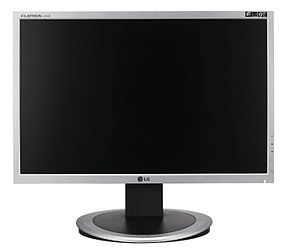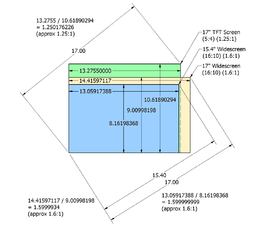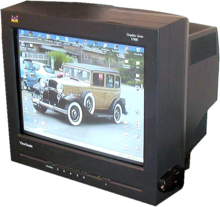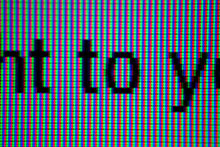Computer monitor

A monitor or display (also called screen or visual display unit) is an electronic visual display for computers. The monitor comprises the display device, circuitry, and an enclosure. The display device in modern monitors is typically a thin film transistor liquid crystal display (TFT-LCD) thin panel, while older monitors use a cathode ray tube (CRT) about as deep as the screen size.
Originally, computer monitors were used for data processing while television receivers were used for entertainment. From the 1980s onwards, computers (and their monitors) have been used for both data processing and entertainment, while televisions have implemented some computer functionality. The common aspect ratio of televisions, and then computer monitors, has also changed from 4:3 to 16:9 (and 16:10).
Contents |
[edit] Technologies
Multiple technologies have been used for computer monitors. Until the 21st century most used cathode ray tubes but they have largely been superseded by LCD monitors.
[edit] Cathode ray tube
The first computer monitors used cathode ray tubes (CRT). Until the early 1980s, they were known as video display terminals and were physically attached to the computer and keyboard. The monitors were monochrome, flickered and the image quality was poor[citation needed]. In 1981, IBM introduced the Color Graphics Adapter, which could display four colors with a resolution of 320 by 200 pixels. In 1984 IBM introduced the Enhanced Graphics Adapter which was capable of producing 16 colors and had a resolution of 640 by 350.[1]
CRTtechnology remained dominant in the PC monitor market into the new millennium partly because it was cheaper to produce and offered viewing angles close to 180 degrees.[2]
[edit] Liquid Crystal
There are multiple technologies that have been used to implement Liquid Crystal Displays (LCD). Throughout the 1990s, the primary use of LCD technology as computer monitors was in laptops where the lower power consumption, lighter weight, and smaller physical size of LCDs justified the higher price versus a CRT. Commonly, the same laptop would be offered with an assortment of display options at increasing price points: (active or passive) monochrome, passive color, or active matrix color (TFT). As volume and manufacturing capability have improved, the monochrome and passive color technologies were dropped from most product lines.
TFT LCD is a variant of LCD which is now the dominant technology used for computer monitors.[3]
The first standalone LCD displays appeared in the mid 1990s selling for high prices. As prices declined over a period of years they became more popular, and by 1997 were competing with CRT monitors. Among the first desktop LCD computer monitors was the Eizo L66 in the mid-1990s, the Apple Studio Display in 1998, and the Apple Cinema Display in 1999. In 2003, TFT LCDs outsold CRTs for the first time, becoming the primary technology used for computer monitors.[2] The main advantages of LCDs over CRT displays are that LCDs consume less power, take up much less space, and are considerably lighter. The now common active matrix TFT-LCD technology also has less flickering than CRTs, which reduces eye strain.[4] On the other hand, CRT monitors have superior contrast, have superior response time, are able to use multiple screen resolutions natively, and there is no discernible flicker if the refresh rate is set to a sufficiently high value. LCD monitors have now very high temporal accuracy and can be used for vision research.[5]
[edit] Organic light-emitting diode
Organic light-emitting diode (OLED) monitors provide higher contrast and better viewing angles than LCDs, and are predicted to replace them. In 2011, a 25 inch OLED monitor costs $6000[citation needed], but the prices are expected to drop.[6]
[edit] Measurements of performance
The performance of a monitor is measured by the following parameters:
- Luminance is measured in candelas per square meter (cd/m2 also called a Nit).
- Aspect ratios is the ratio of the horizontal length to the vertical length. Monitors usually have the aspect ratio 4:3, 5:4, 16:10 or 16:9.
- Viewable image size is usually measured diagonally, but the actual widths and heights are more informative since they are not affected by the aspect ratio in the same way. For CRTs, the viewable size is typically 1 in (25 mm) smaller than the tube itself.
- Display resolution is the number of distinct pixels in each dimension that can be displayed. Maximum resolution is limited by dot pitch.
- Dot pitch is the distance between subpixels of the same color in millimeters. In general, the smaller the dot pitch, the sharper the picture will appear.
- Refresh rate is the number of times in a second that a display is illuminated. Maximum refresh rate is limited by response time.
- Response time is the time a pixel in a monitor takes to go from active (white) to inactive (black) and back to active (white) again, measured in milliseconds. Lower numbers mean faster transitions and therefore fewer visible image artifacts.
- Contrast ratio is the ratio of the luminosity of the brightest color (white) to that of the darkest color (black) that the monitor is capable of producing.
- Power consumption is measured in watts.
- Delta-E: Color accuracy is measured in delta-E; the lower the delta-E, the more accurate the colour representation. A delta-E of below 1 is imperceptible to the human eye. Delta-E’s of 2 to 4 are considered good and require a sensitive eye to spot the difference.
- Viewing angle is the maximum angle at which images on the monitor can be viewed, without excessive degradation to the image. It is measured in degrees horizontally and vertically.
[edit] Size

On two-dimensional display devices such as computer monitors the display size or viewable image size is the actual amount of screen space that is available to display a picture, video or working space, without obstruction from the case or other aspects of the unit's design. The main measurements for display devices are: width, height, total area and the diagonal.
The size of a display is usually by monitor manufacturers given by the diagonal i.e. the distance between two opposite screen corners. This method of measurement is inherited from the method used for the first generation of CRT television, when picture tubes with circular faces were in common use. Being circular, only their diameter was needed to describe their size. Since these circular tubes were used to display rectangular images, the diagonal measurement of the rectangle was equivalent to the diameter of the tube's face. This method continued even when cathode ray tubes were manufactured as rounded rectangles; it had the advantage of being a single number specifying the size, and was not confusing when the aspect ratio was universally 4:3.
The estimation of the monitor size by the distance between opposite corners does not take into account the display aspect ratio, so that for example a 16:9 21 in (53 cm) widescreen display has less area, than a 21 in (53 cm) 4:3 screen. The 4:3 screen has dimensions of 16.8 × 12.6 in (43 × 32 cm) and area 211 sq in (1,360 cm2), while the widescreen is 18.3 × 10.3 in (46 × 26 cm), 188 sq in (1,210 cm2).
[edit] Aspect ratio
Until about 2003, most computer monitors had a 4:3 aspect ratio and some had 5:4. Between 2003 and 2006, monitors with 16:9 and mostly 16:10 (8:5) aspect ratios became commonly available, first in laptops and later also in standalone monitors. Reasons for this transition was productive uses for such monitors, i.e. besides widescreen computer game play and movie viewing, are the word processor display of two standard letter pages side by side, as well as CAD displays of large-size drawings and CAD application menus at the same time.[7][8] 2008 16:10 became the most common sold aspect ratio for LCD monitors and the same year 16:10 was the mainstream standard for laptops and notebooks.[9]
In 2010 the computer industry started to move over from 16:10 to 16:9.
In 2011 non-widescreen displays with 4:3 aspect ratios were only being manufactured in small quantities. According to Samsung this was because the “Demand for the old 'Square monitors' has decreased rapidly over the last couple of years,” and “I predict that by the end of 2011, production on all 4:3 or similar panels will be halted due to a lack of demand.”[10]
[edit] Resolution
The resolution for computer monitors has increased over time. From 320×200 during the early 80s, to 800×600 during the late 90s. Since 2009, the most commonly sold resolution for computer monitors is 1920x1080.[11] Top-end consumer products are limited to 2560×1600 at 30 inches.[12] Apple introduced 2880x1800 with Retina MacBook Pro at 15 inches on June 12, 2012.
[edit] Additional features
[edit] Power saving
Most modern monitors will switch to a power-saving mode if no video-input signal is received. This allows modern operating systems to turn off a monitor after a specified period of inactivity. This also extends the monitor's service life.
Some monitors will also switch themselves off after a time period on standby.
Most modern laptops provide a method of screen dimming after periods of inactivity or when the battery is in use. This extends battery life and reduces wear.
[edit] Integrated accessories
Many monitors have other accessories (or connections for them) integrated. This places standard ports within easy reach and eliminates the need for another separate hub, camera, microphone, or set of speakers. These monitors have advanced microprocessors which contain codec information, Windows Interface drivers and other small software which help in proper functioning of these functions.
[edit] Glossy screen
Some displays, especially newer LCD monitors, replace the traditional anti-glare matte finish with a glossy one. This increases color saturation and sharpness but reflections from lights and windows are very visible. Anti-reflective coatings are sometimes applied to help reduce reflections, although there is certainly room for improvement. A recent example of an anti-reflective surface is Samsung's Ultra Clear Panel which is used on the SA950 and SA750 series monitors. The screen surface is layered with silver nanoparticles to help reduce reflections but these are still visible where ambient light levels are high and little light is outputted from the monitor (i.e. dark areas of an image). Some interesting developments include using a glass surface called 'Invisible Glass' with very low reflectivity or mimicking natural structures such as moth eyes which exhibit such properties.[13]
[edit] Directional screen
Narrow viewing angle screens are used in some security conscious applications.
[edit] 3D
Newer monitors are able to display a different image for each eye, often with the help of special glasses, giving the perception of depth.
- Active shutter
- Polarized
- Autostereoscopic
A directional screen which generates 3D images without headgear.
[edit] Touch screen
These monitors use touching of the screen as an input method. Items can be selected or moved with a finger, and finger gestures may be used to convey commands. The screen will need frequent cleaning due to image degradation from fingerprints.
[edit] Tablet screens
A combination of a monitor with a graphics tablet. Such devices are typically unresponsive to touch without the use of one or more special tools' pressure. Newer models however are now able to detect touch from any pressure and often have the ability to detect tilt and rotation as well.
Touch and tablet screens are used on LCD displays as a substitute for the light pen, which can only work on CRTs.
[edit] Manufacturers
[edit] See also
[edit] References
- ^ "Cathode Ray Tube (CRT) Monitors". Infodingo.com. http://www.infodingo.com/electronics/computer-monitors/types-of-computer-monitors/crt/. Retrieved 2011-05-20.
- ^ a b "CRT Monitors". PCTechGuide.Com. http://www.pctechguide.com/crt-monitors. Retrieved 2011-05-20.
- ^ "TFT Central". TFT Central. 2011-04-30. http://www.tftcentral.co.uk/articles/content/panel_technologies_content.htm. Retrieved 2011-05-20.
- ^ "Is the LCD monitor right for you?". Infodingo.com. http://www.infodingo.com/electronics/computer-monitors/types-of-computer-monitors/lcd/why-choose-an-lcd.aspx. Retrieved 2011-05-20.
- ^ Wang, P. and D. Nikolić (2011) An LCD monitor with sufficiently precise timing for research in vision. Frontiers in Human Neuroscience, 5:85. http://www.frontiersin.org/human_neuroscience/10.3389/fnhum.2011.00085/abstract
- ^ Agoraquest, LLC – The only place for the Sony Enthusiast. "Sony’s Outs Two New OLED Monitors". Agoraquest. http://www.agoraquest.com/article.php?sid=615. Retrieved 2011-05-20.
- ^ NEMATech Computer Display Standards http://www.millertech.com/Technical_Specs.htm
- ^ "Introduction—Monitor Technology Guide". necdisplay.com. Archived from the original on 2007-03-15. http://web.archive.org/web/20070315085244/http://www.necdisplay.com/support/css/monitortechguide/index05.htm. (currently offline)
- ^ "Product Planners and Marketers Must Act Before 16:9 Panels Replace Mainstream 16:10 and Monitor LCD Panels, New DisplaySearch Topical Report Advises". DisplaySearch. 2008-07-01. http://www.displaysearch.com/cps/rde/xchg/SID-0A424DE8-28DF6E59/displaysearch/hs.xsl/070108_16by9_PR.asp. Retrieved 2011-05-20.
- ^ Widescreen monitors: Where did 1920×1200 go? Mybroadband.co.za (2011-01-10). Retrieved on 2011-12-24.
- ^ Monitors/TFT 16:9/16:10 | Skinflint Price Comparison EU. Skinflint.co.uk. Retrieved on 2011-12-24.
- ^ Where are all the high-resolution desktop displays? extremetech.com June 8, 2012
- ^ "Matte vs Glossy Monitors". pcmonitors.org. http://pcmonitors.org/articles/matte-vs-glossy-monitors. Retrieved 10 July 2012.
[edit] External links
| Wikimedia Commons has media related to: Computer monitors |
| |||||||||||||||||


